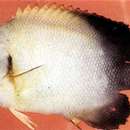Diagnostic Description
provided by Fishbase
Description: Pale tan or light brown becoming blackish on the posterior third of the body and the adjacent fins. Scales on the light portion with white centers. The edge of the gill opening, and the base of the pectoral fins orange. The rear portion of the dorsal and anal fins, and the caudal fin with submarginal narrow blue line. Juvenile similar to adult (Ref. 48636). Body depth 1.7-1.8 in SL. Scales longitudinal series 46-48 (Ref. 90102).
Life Cycle
provided by Fishbase
Distinct pairing (Ref. 205). Monogamous mating is observed as both facultative and social (Ref. 52884).
Morphology
provided by Fishbase
Dorsal spines (total): 14; Dorsal soft rays (total): 15 - 16; Analspines: 3; Analsoft rays: 16 - 17; Vertebrae: 24
Trophic Strategy
provided by Fishbase
Inhabits lagoon and seaward reefs, mainly in coral rich areas (Ref. 1602).
- Recorder
- Drina Sta. Iglesia
Biology
provided by Fishbase
Inhabits lagoons and seaward reefs, mainly in coral rich areas (Ref. 1602). Feeds on algae. Oviparous (Ref. 240), monogamous (Ref. 52884). Frequently exported through the aquarium trade. Form hybrids with Centropyge eibli and C. flavissima at areas of sympatry. Mimicked by juveniles of the acanthurid Acanthurus pyroferus (Ref. 48391).
Importance
provided by Fishbase
fisheries: subsistence fisheries; aquarium: commercial
分布
provided by The Fish Database of Taiwan
分布於印度-太平洋區,由東非洲至馬歇爾群島,北至日本,南至羅得豪島。台灣西部、南部及東部海域可見蹤跡。
利用
provided by The Fish Database of Taiwan
一般以潛水方式捕捉。為觀賞魚類,無食用經濟價值。
描述
provided by The Fish Database of Taiwan
體橢圓形;背部輪廓略突出,頭背於眼上方平直。吻鈍而小。眶前骨游離,下緣凸出,後方具棘;前鰓蓋骨具鋸齒,具一長強棘;間鰓蓋骨短圓。上下頜相等,齒細長而稍內彎。體被稍大櫛鱗,軀幹前背部具副鱗。背鰭硬棘XIV,軟條16;臀鰭硬棘III,軟條16;背鰭與臀鰭軟條部後端鈍長形;腹鰭鈍形;尾鰭圓形。體、背鰭及臀鰭前半部淡黃褐色至乳黃色,後半部暗褐色,體側無任何橫斑。背、臀及尾鰭具藍邊;胸及腹鰭淡黃褐色至乳黃色;尾鰭暗褐色。
棲地
provided by The Fish Database of Taiwan
棲息於潟湖及面海的珊瑚礁靠近珊瑚的水域。多半單獨活動或成小群活動。生性機警,躲躲藏藏,不易看見。主要以海藻、珊瑚蟲、海綿及被囊動物為食。
Centropyge vrolikii
provided by wikipedia EN
Centropyge vrolikii, known commonly as the pearlscale angelfish or half black angelfish, is a species of marine ray-finned fish, a marine angelfish belonging to the family Pomacanthidae. It is found in the Indo-Pacific.
Description
Centropyge vrolikii has a pale greyish to brownish body with marked with whitish scale centres that darken to black towards the tail. The gill slit and base of the pectoral fin are orange. The caudal fin and posterior part of the dorsal and anal fins have a blue margin.[3] The dorsal fin contains 14 spines and 15–16 soft rays while the anal fin has 3 spines and 16–17 soft rays. This species attains a maximum total length of 12 centimetres (4.7 in).[2]
Distribution
Centropyge vrolikii is found in the Indo-Pacific region. Its range extends from Christmas Island in the west to Vanuatu and the Marshall Islands in the east, north to Taiwan and south to Lord Howe Island.[1] In continental Australia it also occurs off north-western Western Australia and on the northern parts of the Great Barrier Reef of Queensland, as far south central coast of New South Wales.[4]
Habitat and biology
Centropyge vrolikii is found at depths between 1 and 25 metres (3.3 and 82.0 ft).[1] This species is found in lagoons and seaward reefs, most frequently in areas of dense coral growth.[2] They are common where there is a rock or rubble substrate, particularly where there is rich and varied algal and sponge growth.[4] It is a largely herbivorous species which feeds on filamentous algae,[2] but also on sponges.[4] This species is able to change sex from female to male: when there is no male in a harem, one of the females changes sex.[5] The juveniles of the mimic surgeonfish (Acanthurus pyroferus) mimic this angelfish.[4]
Systematics
Centropyge vrolikii was first formally described as Holocanthus vrolikii in 1853 by the Dutch physician, herpetologist and ichthyologist Pieter Bleeker (1819–1874) with the type locality given as Ambon Island.[6] The specific name honours the Dutch anatomist and pathologist Willem Vrolik (1801–1863). Some authorities place this species in the subgenus Centropyge;[7] where they are sympatric this species will hybridise with C. eibli and C. flavissima.[2]
Utilisation
Centropyge vrolikii is common in the aquarium trade.[1]
References
-
^ a b c d Pyle, R.; Myers, R.F.; Rocha, L.A. (2010). "Centropyge vrolikii". IUCN Red List of Threatened Species. 2010: e.T165860A6150674. doi:10.2305/IUCN.UK.2010-4.RLTS.T165860A6150674.en. Retrieved 20 November 2021.
-
^ a b c d e Froese, Rainer; Pauly, Daniel (eds.) (2019). "Centropyge vrolikii" in FishBase. December 2019 version.
-
^ Bray, D.J. (2017). "Centropyge vrolikii". Fishes of Australia. Museums Victoria. Retrieved 2 February 2021.
-
^ a b c d Mark McGrouther (30 August 2019). "Pearlscale Angelfish, Centropyge vrolikii (Bleeker, 1853)". Australian Museum. Retrieved 2 February 2021.
-
^ "Centropyge vrolikii". reefapp.net. Retrieved 2 February 2021.
-
^ Eschmeyer, William N.; Fricke, Ron & van der Laan, Richard (eds.). "Species in the genus Centropyge". Catalog of Fishes. California Academy of Sciences. Retrieved 2 February 2021.
-
^ Christopher Scharpf & Kenneth J. Lazara (21 July 2020). "Order ACANTHURIFORMES (part 1): Families LOBOTIDAE, POMACANTHIDAE, DREPANEIDAE and CHAETODONTIDAE". The ETYFish Project Fish Name Etymology Database. Christopher Scharpf and Kenneth J. Lazara. Retrieved 2 February 2021.

- license
- cc-by-sa-3.0
- copyright
- Wikipedia authors and editors
Centropyge vrolikii: Brief Summary
provided by wikipedia EN
Centropyge vrolikii, known commonly as the pearlscale angelfish or half black angelfish, is a species of marine ray-finned fish, a marine angelfish belonging to the family Pomacanthidae. It is found in the Indo-Pacific.
- license
- cc-by-sa-3.0
- copyright
- Wikipedia authors and editors

